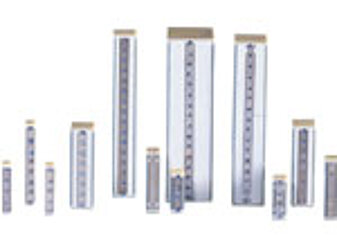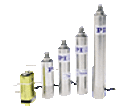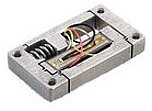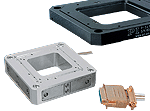When designing (internally or externally) preloaded Piezo systems, the stiffness of the preload spring should be less than 1/10 of the Piezo stiffness. Otherwise too much of the unloaded displacement would be sacrificed. If the preload spring has the same stiffness as the Piezo, displacement will be cut in half.
Displacement with External Forces
Like any other actuator, a piezo actuator is compressed when a force is applied. Two cases must be considered when operating a Piezo with a load:
a) the load remains constant during the motion process
b) the load changes during the motion process.
Case a
(Force = constant)
Zero point is offset
A mass is installed on the Piezo which applies a force F = M * g (M: mass, g: acceleration due to gravity). The zero point will be offset by an amount DLN » F/kT, where kT equals the stiffness of the Piezo. If this force is within the specified load limit (technical data), full displacement can be obtained at full operating voltage.
ΔLN ≈ F/kT (4-5)
Zero point offset with constant force where
ΔLN =Zero point offset [m]
F = Force (generated by mass and gravity) [N]
kT = Piezo actuator stiffness [N/m]
Example:
Q: How large is the zero point offset of a 30 µm Piezo actuator with a stiffness of 100 N/µm if a load of 20 kg is applied and what is the maximum displacement with this load?
A: The load of 20 kg generates a force of 20 kg * 9.81 m/s2 = 196 N. With a stiffness of 100 N/mm, the piezo actuator is compressed slightly less than 2 mm. The maximum displacement of 30 µm is not affected by this constant force.
Case b
(Force on the Piezo is a spring)
Force = Function (ΔL):
displacement is reduced
For Piezo operation with spring loads different rules apply. The "spring" could be an I-beam or a single fiber each with its characteristic stiffness or spring constant. Part of the displacement generated by the piezo effect is lost due to its elasticity of the piezo element. The total available displacement can be related to the spring stiffness of by the following equations
ΔL ≈ ΔL0 (kT/(kT+kS)) (4-6)
Maximum displacement of a piezo actuator acting against a spring load.
ΔLR ≈ ΔL0 (1- kT/(kT+kS)) (4-7)
Maximum displacement loss due to external spring force. In the case where the spring stiffness ks is ∞ (infinitely rigid restraint) the Piezo only acts as a force generator.
where
ΔL = displacement with external spring load [m]
ΔLO: max. nominal displacement without external force or restraint [m]
ΔLR = lost displacement caused by the external spring [m]
ks = spring stiffness [N/m]
kT = Piezo actuator stiffness
Example:
Q: What is the maximum displacement of a 15 µm Piezo translator with a stiffness of 50 N/µm, mounted in an elastic restraint with spring constant ks (stiffness) of 100 N/mm ?
A: Equation 4-6 shows that the displacement is reduced in an elastic restraint. The spring constant of the external restraint is twice the value of the piezo translator. The achievable displacement is therefore limited to 5 mm (1/3 of the nominal travel).
If you have any questions, ask a PI engineer for help.

